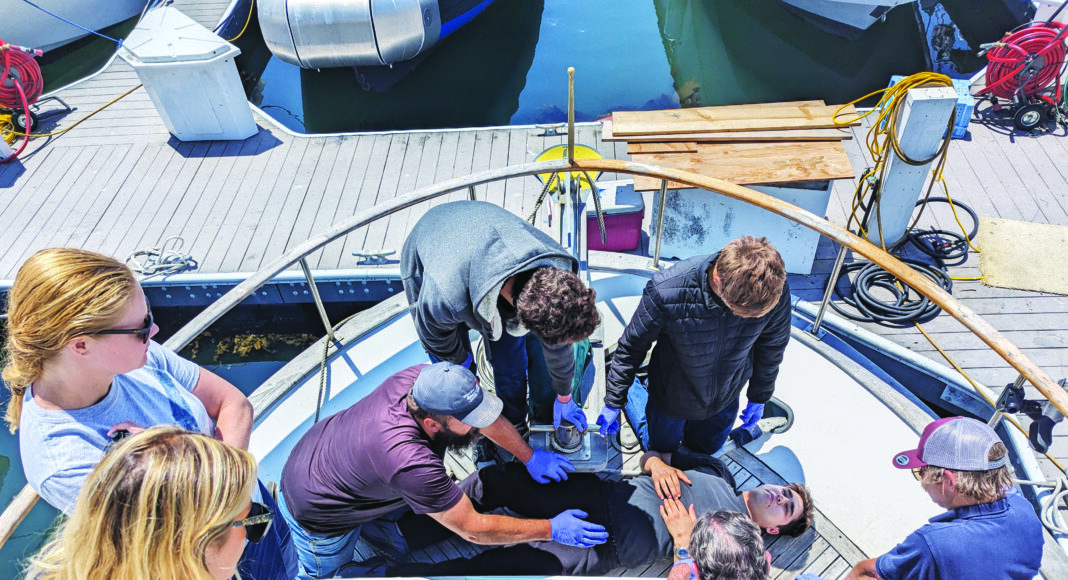Don’t let the amputated thumb distract you.
Not from the dangerous deck conditions brought on by heavy seas. Not from your spiking heart rate. Not from the hidden foot wound that might kill the fisherman missing the finger.
These are some of the mantras soaked up by local fishermen who participated in the first annual Fisherman First Aid and Safety Training this summer. The training is hosted by Monterey Bay Fisheries Trust in partnership with California and Oregon Sea Grant.
“Commercial fishing is a dangerous and challenging occupation,” the introduction reads. “The risk of injury is always present.”
As one of the attending fishermen, Wesley Williams, puts it, noting that a fish spine in his foot has already sent him to the hospital: “Commercial fishing is not a joke. It’s the hardest job I’ve had in my life.”
During the 20-year period 2000–2019, the National Institute for Occupational Safety and Health tallied 141 deaths due to traumatic injury occurred in West Coast fisheries. Drowning, blunt force trauma and embolism were the three most common causes of fatalities, in that order. Meanwhile, the annual number of fatalities has generally declined over those two decades.
“Commercial fishing is particularly dangerous because it combines long, physically demanding labor operating heavy equipment in harsh conditions,” Palinkas says. “Oftentimes being far away from emergency care.”
And safety regulations are challenging to apply.
“What rules that are in place are difficult if not impossible to always enforce due to the remote nature of being far out at sea,” she says.
California Sea Grant (CSG) organized the two-day session, which was held at the Santa Cruz Harbor’s Public Meeting Room, with simulated drills aboard the FV Classic Lady, one of Santa Cruz’s resident commercial fishing vessels. (Its captain, Doug Gilbert, was among those who attended.)
It’s a unique organization whose partnership unites the resources of the federal government (including NOAA Fisheries), the State of California and dozens of universities across it to benefit the economy and the environment. It was built upon a similar land grant program to support the agriculture industry through science, research and innovation.
CSG Marine Research Associate Ashleigh Palinkas oversaw the affair, and the slate of activities proved brisk. One morning alone included training and simulation drills around evacuations, hypothermia/frostbite, abdominal injuries, how to move wounded crew, drowning epidemiology and prevention and more.
“This is targeted survival skills, with more realistic scenarios that would be likely to happen on a boat, removing the assumption you can get someone to the hospital within minutes or even hours. It’s the best safety training fishermen can get besides wilderness first responder,” she says.
On top of that, the weekend workshop was provided free of charge, with breakfast and lunch included. (Wilderness first responder classes, meanwhile, can take up to eight days and run $2,400.)
No death by PowerPoint here: Fishermen took turns playing the impaled, knocked out or otherwise bruised and bleeding victims while the Sea Grant team led them through the ways to navigate the trauma.
“It sounds bleak, but once you start thinking about what can go wrong [out there], you realize how much really can!” Palinkas says. “It’s heavy information and we do a lot of repetition, so when they find themselves in the scenario, it removes a lot of decision-making under stress, creating a controlled response rather than a frantic reaction.”
At one point a fisherman pantomimes the loss of a finger and his colleagues run through stages of assessment, including vital signs with the help of checklists like AVPU (alertness, verbal response, pain response, unresponsiveness).
“Don’t rush! Do the same assessment every time and it’s easy!” Doerr says. “Don’t let the amputated thumb distract you from other issues!”
Completing the course means fisher folk can meet the U.S. Coast Guard requirement that one or more crew on board be first aid- and CPR-trained. It also provides powerful capabilities and the peace of mind that comes with it—and, by the way, a free first aid kit filled with equipment they spent the class days learning how to use.Find additional resources at Fishermen Led Injury Prevention Program. A version of this piece originally appeared on nonprofit Monterey Bay Fisheries Trust’s website.












